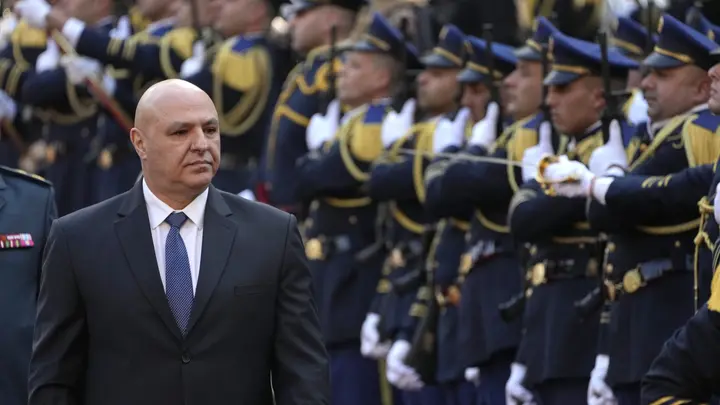Fierce clashes erupted along the Syrian-Lebanese border on Monday as Syria’s newly formed government engaged in deadly confrontations with Hezbollah-affiliated forces. The escalation follows allegations that Hezbollah militants infiltrated Syrian territory, abducted three Syrian soldiers, and executed them inside Lebanon.
In response, the Syrian military launched artillery strikes targeting Hezbollah positions, specifically locations believed to have been used by the group’s fighters responsible for the executions. Hezbollah, however, has denied any involvement in the alleged killings.
According to the Lebanese newspaper Al-Akhbar, which has ties to Hezbollah, the Syrian army successfully took control of the border village of Hawsh al-Sayyid Ali during the ongoing clashes. Reports suggest that the heaviest fighting is centered around Al-Qasr, another key location along the border. Meanwhile, Saudi-owned Al Arabiya reported intermittent skirmishes between the Syrian army and Hezbollah fighters and claimed that a Hezbollah ammunition depot in Lebanon was destroyed by Syrian artillery fire.

Lebanese President Joseph Aoun addressed the worsening situation, declaring, “The ongoing violence on our eastern and northeastern borders cannot persist. I have instructed the Lebanese army to respond to any attacks on our territory.”
The Syrian Observatory for Human Rights reported that at least five additional Syrian soldiers lost their lives in the fighting. As the conflict spreads, civilians—including families with young children—have been seen fleeing toward the Syrian village of Hermel for safety.
Syria’s New Leadership Vows Retaliation
Syria’s interim government, led by Ahmad al-Sharaa, issued a strongly worded statement condemning Hezbollah’s alleged actions and vowing a decisive response. Al-Sharaa’s government, which emerged after the downfall of former President Bashar al-Assad, has been actively working to consolidate control over Syrian territory.
“They kidnapped our soldiers and executed them in Lebanon. The Ministry of Defense will take all necessary measures to counter Hezbollah’s aggression,” the government statement read.
A Power Struggle Between Rivals
The conflict highlights deep-rooted sectarian and ideological tensions. The Syrian government, backed by the Sunni-dominated group Hayat Tahrir al-Sham (HTS), and Hezbollah, a Shiite organization supported by Iran, represent opposing sides in the battle for regional influence. HTS, formerly associated with al-Qaeda, has sought to rebrand itself as a nationalist movement opposing Iranian-backed groups in Syria.

Javed Ali, a professor at the University of Michigan’s Ford School of Public Policy and a former senior director at the U.S. National Security Council, noted that Hezbollah is facing a precarious situation. “Hezbollah is trying to exploit Syria’s transition period, but the group itself is under immense pressure. Israeli strikes, the fall of Assad, and now the rise of new adversaries in Syria have significantly weakened its position.”
The collapse of Bashar al-Assad’s government in December marked a turning point for Hezbollah, which had spent years supporting his regime alongside Iran and Russia. In late November, Syrian rebels launched a surprise offensive against Assad’s forces, ultimately leading to his downfall.
Now in power, HTS has taken steps to curb weapons and drug smuggling along the Syria-Lebanon border, directly challenging Hezbollah’s operations. The new government has also begun military deployments to tighten border security, restricting Hezbollah’s movements in the region.
Hezbollah’s Regional Challenges Mount
Ali highlighted that Hezbollah is experiencing a convergence of threats unlike any in its history. “With HTS consolidating its control in Syria, Hezbollah’s overland weapons supply routes from Iran are being severely disrupted. This could significantly degrade its operational capabilities.”
The U.S. has taken a cautious approach toward Syria’s new leadership. While HTS remains designated as a terrorist organization by Washington, analysts suggest that the group’s pragmatic stance should be closely observed.

“The U.S. is navigating a complex situation in Syria. While it does not officially support HTS, there are strategic advantages to limiting Hezbollah and Iranian influence,” Ali noted.
HTS has sought to distance itself from its extremist past, portraying itself as an Islamist nationalist force resisting Iranian interference. While skepticism remains, the group’s control over key regions in Syria poses a significant obstacle to Hezbollah’s operations.
Growing Internal Pressure in Lebanon
Beyond Syria, Hezbollah is also facing increasing opposition within Lebanon. The group’s setbacks in recent confrontations with Israel have emboldened its domestic critics, who view this as an opportunity to diminish its influence in Lebanese politics.
Former Lebanese President Michel Aoun warned of three major threats to Lebanon’s stability: ongoing Israeli military actions, Hezbollah’s involvement in cross-border conflicts, and the unresolved Syrian refugee crisis.
“Officials must act immediately to ensure the nation’s security and protect its citizens,” Aoun emphasized.
Adding to the complexity, Mounir Shehadeh, a former Lebanese government liaison with the United Nations peacekeeping mission, disputed reports of Hezbollah’s activity in the northeastern Bekaa Valley. “There is no Hezbollah presence in this region, as confirmed by local communities,” Shehadeh stated. His comments raise questions about the true extent of Hezbollah’s influence along the Lebanese-Syrian border.
While efforts are being made to contain the crisis, analysts warn that the risk of further escalation remains high. The long-term implications of these developments are uncertain, but Hezbollah’s regional dominance appears to be under increasing strain.





